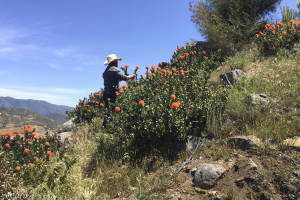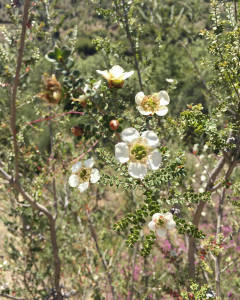
The Resendiz Brothers Protea Farm is Manifesting The American Dream
A few weeks ago while at the Field to Vase Dinner in the Carlsbad Flower Fields, I met an iconic California protea farmer named Mel Resendiz. The Resendiz Brothers grow 75 varieties of flowering plants and foliage in Southern California, all of which is grown from seeds or propagated from cuttings that they supply to commercial flower growers, specialty nurseries, garden centers, as well as residential and commercial landscapers across the state.
On the evening of this fateful encounter I had just realized my own passion for a South African native that Resendiz happens to grow– the pincushion. “How did they sneak that bad boy in here?” I thought, when I saw the flower at the Field to Vase dinner. “Surely it’s not natively grown?”
By the end of the evening Resendiz had invited me to his farm, to experience a sensory feast of color and texture on Rainbow Creek Road, in Fallbrook, California.
Days later I found myself standing on the top of a mountain, making the acquaintance of countless Banksia, Kangaroo Paws, Leucadendron, Pincushion, Protea, Grevillea, endless filler flowers like Boronia and Waxflower, lacy and feathery foliage, and other Proteaceae. Equally as moving as the plant matter, flowers, and view was the story of how Resendiz got this point– growing a protea empire in the unlikely desert of Southern California.
Resendiz came to the States in 1978, when he was 18-years-old. He had spent the last five years working on a sugar cane farm in the state of Sinaloa. “It was one of the hardest jobs,” Resendiz told me.
“I was thirteen and woke up at 2 A.M. everyday to get to work at 6 A.M., with my father and brother. We worked until 4 and made $100 a week. We heard about people in the U.S. making $20 a day cleaning yards or pulling weeds. I told my father, ‘I’m tired of cutting sugar cane and I’m leaving tomorrow for California’. I had 1,500 pesos. The ticket from Sinaloa to Tijuana was half of that. I ended up with $50 or $60 leftover, and that’s what you had to pay the coyote. Because I knew him from Sinaloa, he said ‘Work, then come back and pay me’.”
“One of my first jobs in the U.S. would be clearing brush, propagating, grafting, and taking care of 40-acres of protea which I planted every five feet,” he smiled, recalling his initial entry into the work that has since become his specialty.
“One of my first jobs in the U.S. would be clearing brush, propagating, grafting, and taking care of 40-acres of protea which I planted every five feet,” he smiled, recalling his initial entry into the work that has since become his specialty.
The owner of the protea farm that Resendiz worked on was from Johannesburg, South Africa, where protea grows natively. He had been growing Camellias on a smaller plot, but after a trip home he was inspired to grow the approximately 300 million year old flower– one of the oldest families of flowers to grow on earth. Protea weren’t as common in the ‘70s as they are today, and they sold for about 35-50 cents a flower.
With over 10,000 stems being produced, the farm was unable to sell them all. “Every Thursday, the manager had me dump 9,000 flowers in the canyon,” Resendiz explained. “I was working five days a week and making $100.”
After the 40-acres his boss’ farm occupied was planted, Resendiz was asked to sell the leftover protea. A flower farmer on Rainbow Road purchased them and hired Resendiz to teach him how to plant and prune on the weekends.
“He was giving me $150 a day and would let me have all the pruning from the flowers. Sometimes I would leave with a few hundred. But one weekend, the manager from the farm that I was at during the week followed me. He wanted to know if I was stealing flowers. The manager said that if I didn’t stop working for Rainbow Protea, he didn’t want me at the farm. So, I left.”
Resendiz soon started working for another farm, planting Macadamia trees. The owner had 1,000 of them, but he wanted to grow protea. “We planted 100,000 of them in one month,” he recalls. “One month later, the owner of the farm that I was originally at said he wanted me to come back. His manager was leaving and he offered to pay me $15,000”, he added. Resendiz accepted this offer and with the money, and his savings, he purchased a house in Escondido.
In 1999, the $250,000 farm that Resendiz was instrumental in getting off the ground sold for $15.5 million. When they sold the farm, he stayed there for a year as he began to grow and sell protea on his own land. Next he would purchase 3,000 acres of land in Fallbrook, where his office, propagation, and distribution center stand today.
Shortly after he was established on the 3-acres of land, Resendiz was approached by a realtor who said that there were 10-acres for sale on Rainbow Crest. “They wanted $25,000 for the brush, and the land had a water meter. After clearing the brush and planting protea, we had a lot of rain. It was 1996-1997 [the year of El Niño], so we had beautiful pincushions,” he recalls of the period.
Resendiz continued to invest his earnings in property, and today he has approximately 200-acres planted with protea, some of which are now up to 40 years old. That was the farm he invited me to explore after the Field to Vase dinner, where we met.
Together, Resendiz and I patrolled the grounds as he told me his story. We gazed across the mountaintops and saw nothing but the flowers he planted in every direction. The wind was humming, and I realized that everything a protea symbolizes– courage, strength, and transformation– is also true of Mel Resendiz, and all that his flowers have come to represent.










































